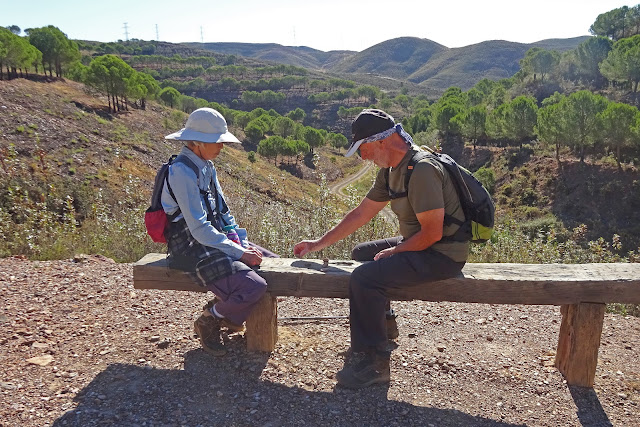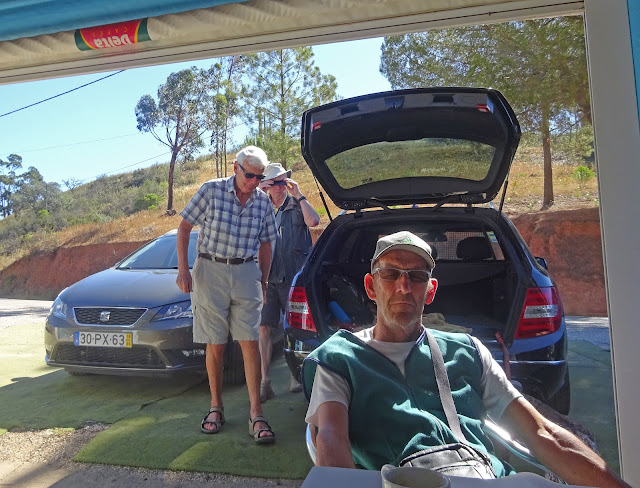When a small number of us gathered at Herdade do São Bom Homem on 29th June, water shortages and how many words for snow there are in the Inuit languages were among the many topics of conversation that kept tongues wagging.
We set off at quite a pace – at least the men did, but they then had to wait for the ladies to catch up.
As we moved further up the hill, Myriam enthralled us with her heart-rending tales of hardships in her young days in Hong Kong when they were only allowed water once in every four days, or something like that.
Typical colonial life, no doubt.
On top of the first hill, we had views over to the windmill and Silves Castle, and we then came across a patch which is clearly a local inhabitant´s private retreat for watching the sunset– a chaise longue and a dinner plate with the remains of a slice of bread.
Maria could not resist the temptation of the recliner and had a quick lie-down.
We circled round and took the middle road home, over a pleasant undulating track.
Then there was the sting in the tale or tail. A very steep hill, to the highest point of the walk, which Terry zoomed up.
When the rest of us caught up with Terry, he was contemplating the scenery along with Becky.
We paused at Rest and Be Thankful for a banana stop. There is only one possible caption for this next picture.
.jpg) |
| JohnH has difficulty in getting his leg over |
and Yves introduced Myriam to the ancient game of Naughts and Crosses, played with stones in the true neolithic fashion.
On the way back down to the cars, Yves, who was in true Aristotelian form all morning, first raised the subject of Eskimos and their feelings for snow first came up. What a can of worms he introduced !
Moving Average: 3.25 kph. Fried egg count: 19.
Then to Para e Fica in good time for breakfast. Our friendly waitress was Georgette, previously known to some of us from Casinhas in the old days.
The Lagos contingent arrived just before the 10 am serving time. First to be served was JohnH, which made a welcome change.... for him at least.
Becky enjoyed her fair share of toast.
Then the subject of how many words the Inuit have for snow came up again which reminded Antje of the book, Miss Smilla´s Feelings for Snow.
One explanation of the belief that Inuits have many words for snow is that
Inuit languages are polysynthetic, i.e., grammatical functions are represented by a strings of suffixes attached to roots and stems. As a result, Inuit languages have many long words that are equivalent to whole sentences in analytical languages such as English. For example, the Inuktitut word tusaatsiarunnanngittualuujunga ‘I can’t hear very well‘ is made up of the elements tusaa ‘hear’ + tsiaq ‘well’ + junnaq ‘able to’ + nngit ‘not’ + tualuu ‘very much’ + junga ‘lst person singular, present, indicative, non-specific.’ Got that? Good. But how one learns a language like that, I don´t know..
If you want a more light-hearted treatment of this fascinating subject, I recommend you look up:-
http://ontology.buffalo.edu/smith/varia/snow.html
where you will find ”The Eskimos´ Hundred Words For Snow” by one Phil James. His list includes such examples as
“quinaya” = snow mixed with Husky s**t.
“ylaipi” = tomorrow´s snow.
“tlanip” = snow sold to Japanese tourists, and
“depptla” = a small snowball, preserved in Lucite, that has been handled by Johnny Depp.
(It is, of course, a satirical list.)
And then there is another site
https://www.k-international.com/blog/which-language-has-the-most-words-for-snow/ which provides the following answers:-
Inuit :40 -50 ; Swedish; 25; Sami: 180; Icelandic: 46; and Scots: 421.
Can anyone believe that? See what I meant by “a can of worms.”
But Aristotle´s thirst for knowledge did not end there, for while we were still breakfasting, he asked “What does the “São” mean on that sign near where we parked?”
Some said "São" meant “they are”. others said it meant “Saint” e.g. São Marcos (St Mark).
There is also the adjectival use of the word to mean “health”.
Myriam, into her role as WAGS Chief Researcher and has come up with the following authoritative explanation:-
Man-good is an expression that, from the Middle Ages onwards , in Portugal and in colonial Brazil , members of the village community and towns who had a certain social relevance, either because they owned properties or other assets , [ 1 ] or because they exercised trades . not manual. Being a good man meant participating in the voter lists that chose the members of the municipal councils , being able to vote and be voted on. In Colonial Brazil , a good man was commonly the Old Christian landowner. From this category, slaves were excluded.and other manual workers , and New-Christians (that is, those who did not have Christian parents and grandparents), among others.
Enough
said; this blog is becoming a bit too long.

.JPG)


.jpg)

















3 comments:
One must not forget the vital instruction shouted out by Inuit guides, when they can be bothered:
"Stoppliyekeanureevesov!" which translates very loosely as "Don't eat the yellow snow!"
The story of water forgot to mention a certain expat family of 5 who had to take turns to wash in the same bath water in Kenya!!
I appreciate your quiet yet determined leadership for APAPS and particularly enjoy the blogs from a non-walkers point of view. A flawless and relevant choice of music adds to the experience. Where does it go from here. I am hoping to recover from my current ennui and blogging apathy to complete the WAGS and the seasons final blog. A few more brekkers like these might do the trick.
Post a Comment